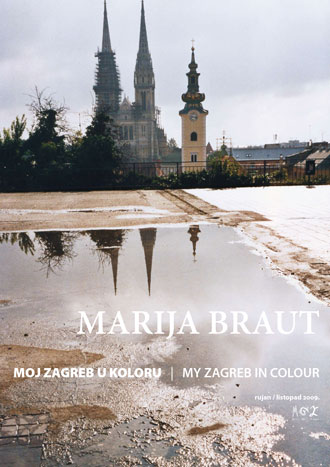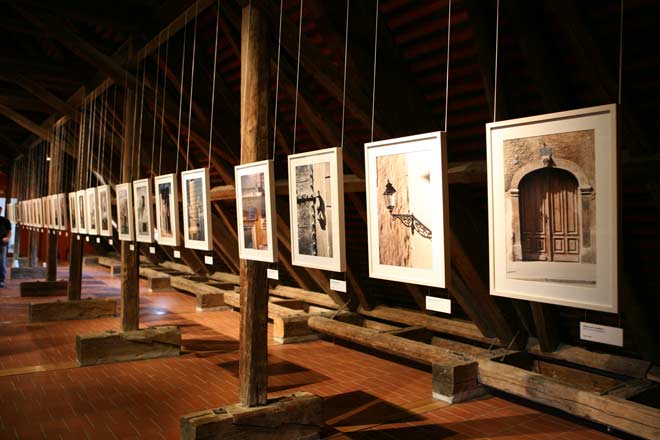Marija Braut: My Zagreb in Colour
Exhibition concept: Iva Prosoli
Exhibition design: Tajana Zver
Poster design: Tajana Zver
 The exhibition My Zagreb in Colour is a new visit to the city of Zagreb by one of its photographic icons, Marija Braut.
The exhibition My Zagreb in Colour is a new visit to the city of Zagreb by one of its photographic icons, Marija Braut.
For forty years by now this great photographer of restless spirit, commonly called the first lady of Croatian photography, has roamed camera in hand, and recorded. Documented. Put away. Since her artistic beginnings in the studio of the great master of photography Tošo Dabac and her first exhibition in 1969 she has been exhibiting, working for magazines, theatres, museums, galleries and other institutions.
She recalls past times, exhibitions, people and friendships with nostalgia. Known for her lyrical black and white photography, this time she is concerned with pictures in colour, portraits of her favourite model, the city of Zagreb. The pictures reveal to us her movement and her love for her town.
The photographs at this exhibition were created in the last ten years or so and are part of the Marija Braut Donation to Zagreb City Museum.
Interview with Marija Braut: “Nothing can replace the neg”
IP: What attracted you to photography?
MB: I’ve always liked looking. As long as I have been alive, I have always seen, and I can say that photography was close to me even before I started taking pictures. Since my husband was a journalist, he often brought home various journals; I liked National Geographic the best. In time we collected a real library of these magazines, even the children looked over them with respect, never tore them up. My children have also thus been brought up on looking. Even today, my grandchildren have this collection.
IP: What does it mean to you to take Zagreb?
MB: Zagreb is my town. I got to know it by photographing it. I have certain regular routes, but I have also explored new parts of the town, photographing on commission; once I photographed all the parks in Zagreb. And so I got to know places that otherwise I would never have managed to. I cannot not photograph Zagreb, when I am in it every day. I see something everyday. I see, but just recently I haven’t always had camera in hand. I am sorry. How many pictures I have in fact made that way with no camera.

IP: Which part of the town do you like best?
MB: I like sitting on Katarina's Square, in the middle of the Upper Town, feeling it my own since I first came to Zagreb. On Katarina's Square I went to high school for eight years, graduated high school there. Later I worked close, first of all in the Galleries of the City of Zagreb, today’s Museum of Contemporary Art, then in the Museum of the Naïve, the Meštrović Gallery, the Benko Horvat Foundation. That was a lot of work, I took pictures for exhibition catalogues. We hung around a lot. Here artists and art historians and others would get together, people were always coming, talking about the fine arts.
IP: What’s the difference between photographing people and photographing a city?
MB: At base, nothing. For each human face has its own expression, and the city has its own expression, something that it shows of its own. And the approach is actually the same. Only technically different.
 IP: Has Zagreb changed essentially over the years you have been photographing it?
IP: Has Zagreb changed essentially over the years you have been photographing it?
MB: A lot has been built, but the spirit has remained. The spirit has remained in the old parts that have remained unchanged. In the winding streets of Upper Town, in the zigzag rhythm of Ilica. But I don’t like the way some things have changed.
For example, the clock on Jelačić Square, which the old Agram people put there to be seen from everywhere, has been moved. Now you see it from nowhere. Or the Stock Exchange Square, it was perfect when designed by Viktor Kovačić, and now a fountain has been put there. Some things just can’t be touched, there’s a reason why they are the way they are.
IP: Do you find colour photographs a novelty, have you done them before?
MB: I used to do them only on commission, but today I do them primarily from practical reasons. I simply took a colour film and felt it might be all right. Just by looking around you, you attain a sensitivity for colour.
But my black and white shots are still more important for me, I don’t know why. But it is not likely that all the people on the black and white photographs unerringly feel the colours, know when the sky is blue, when the clouds are grey. I’ve never tried digital. I know it’s practical, but I have no need now to change my habits. Apart from that, a negative is worth more than a digital file. Nothing can replace the neg.
Iva Prosoli







photo Miljenko Gregl, ZCM
 Exhibition catalogue
Exhibition catalogue
Prosoli, Iva. Marija Braut : My Zagreb in colour.
Zagreb : Zagreb City Museum, 2009

